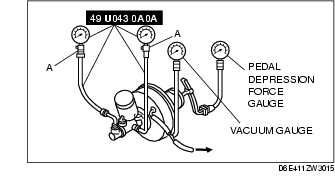
1. With the engine stopped, depress the pedal a few times.
2. With the pedal depressed, start the engine.
3. If the pedal moves down slightly immediately after the engine starts, the unit is operating.
1. Start the engine.
2. Stop the engine after it has run for 1-2 min.
3. Depress the pedal with the usual force.
4. If the first pedal stroke is long and becomes shorter with subsequent strokes, the unit is operating.
1. Start the engine.
2. Depress the pedal with usual force.
3. If the pedal height does not change, the unit is operating.
4. Hold the pedal down for approx. 30 s.
5. If the pedal height does not change, the unit is operating.
1. Connect the SSTs, vacuum gauge, and pedal depression force gauge as shown in the figure to bleed the air from the SSTs and brake line. (Bleed the air from the SSTs using a air bleed valve A.)
1. Stop the engine when the vacuum gauge reading reaches 66.7 kPa {500 mmHg, 19.7 inHg}.
2. Observe the vacuum gauge for 15 s.
1. Start the engine.
2. Depress the brake pedal with a force of 196 N {20 kgf, 44 lbf}.
3. Stop the engine when the vacuum gauge reading reaches 66.7 kPa {500 mmHg, 19.7 inHg}.
4. Observe the vacuum gauge for 15 s.
5. If the gauge shows 63.3-66.7 kPa {475-500 mmHg, 18.7-19.6 inHg}, the unit is operating.
1. When the engine is stopped (vacuum 0 kPa {0 mmHg, 0 inHg}) and the fluid pressure is within the specification, the unit is operating.
Power brake unit fluid pressure when pedal depressed at 200 N {20 kgf, 44 lbf}2. Start the engine. Depress the brake pedal when the vacuum reaches 66.7 kPa {500 mmHg, 19.7 inHg}.